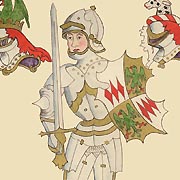Edmund Plantagenent, Earl of Rutland, was second son to Richard, Duke of York, who fought alongside his father at the Battle of Wakefield.
BOY CHANCELLOR
Rutland was born in Rouen, France, in 17 May 1443 as the fifth child and second surviving son of the Duke of York and Cecily Neville. Edmund was granted the Earldom in 1446 and was tutored by Richard Croft at Ludlow Castle, his father's Shropshire estate. York showed his love to his eldest sons, Edward, Earl of March, and Rutland, by giving them green gowns as Easter gifts in 1454 despite York being busy at court becoming Protector of the Realm that spring.
York held the title Lieutenant of Ireland and appointed Rutland as Lord Chancellor of Ireland when his son was just eight-year-old. With Rutland underage, governing Ireland's coffers was tasked to Deputy Chancellors Edmund Oldhall, brother to York's Chamberlain, and then John Talbot, Earl of Shrewsbury.
Following defeat at the Battle of Ludford Bridge on 12 October 1459, York took Rutland to Ireland via Devon and Wales, whilst leaving his wife and young children, Margaret, George and Richard, to the might of the royal army. The 16-year-old Rutland was able to study his father command order and respect in Ireland but soon discovered their stay in exile wouldn't last long after York discussed return plans with his nephew, Richard Neville, Earl of Warwick, at Waterford in spring 1460.
York and Rutland returned from Ireland on 8 September 1460, landing in north Wales, and traveled to Ludlow and Hereford. It was at Hereford where Rutland met up with his mother and younger siblings but he followed his father's march south to London. York's march was signaled with the flying of the royal standard as if it was his own and York proclaimed his right to the throne by placing a hand upon it on 10 October 1460.
York's actions were derisive and alienated his supporters including Warwick and his father, Richard Neville, Earl of Salisbury. An incensed Warwick challenged York in the pretender's Westminster apartments but a brave and loyal Rutland came to his father's defence by saying to Warwick, "Fair Sir, be not angry, for you know that we have the true right to the crown, and that my lord and father must have it."
 |
| Rutland clashed with the Earl of Warwick following York's public claim to the throne |
Rutland's older brother Edward, who had escaped Ludford Bridge to Calais with Warwick, looked to calm the atmosphere by saying to Rutland, "Brother, vex no man, for all shall be well." Edward left the apartments with Warwick and Rutland stayed by his father's side. Later that month, Parliament passed an Act of Accord that decreed York and his heirs would inherit the throne after Henry VI, despite the fact that the king had a son, Prince Edward of Westminster.
Rutland accompanied his father's march north from London on 9 December 1460 after York and Salisbury's northern estates had been looted by Lancastrian forces. After a skirmish with the troops of Henry Beaufort, 3rd Duke of Somerset, at Worksop, Nottinghamshire, York's army reached Sandal Castle near Wakefield on 21 December 1460.
BATTLE
The Battle of Wakefield on 30 December 1460 saw York lead his men out of Sandal Castle in search for a foraging party who had earlier left under the apparent safety of a Christmas truce. The Lancastrian forces were led by Somerset, Henry Percy, Earl of Northumberland, and Lord John Clifford, whose fathers had all died at First Battle of St. Albans five years previously.
York was ambushed on Wakefield Green and commanded his son to flee the battle to meet up with his brother, Edward, who was building up reinforcements in the Welsh marches. Under protest, Rutland left the battlefield and made it as far as Wakefield Bridge before he was captured. Clifford met his captive on the bridge and was urged by Rutland's tutor, priest Robert Aspell to ransom Rutland, "for he is the Prince's son, and peradventure may do you good hereafter." Clifford replied in anger, "By God’s blood, thy father slew mine and so will I do thee and thy kin,” before stabbing Rutland to death.
 |
| Rutland begs Sir John Clifford for mercy |
The decapitated head of Rutland would soon join the heads of his father and uncle on spikes atop of Micklegate Bar in York. The bodies of Rutland and York were hastily buried in Pontefract Priory until Edward, now King Edward IV, reinterred them in the family vault at Fotheringhay Castle on 30 January 1466.

No comments:
Post a Comment